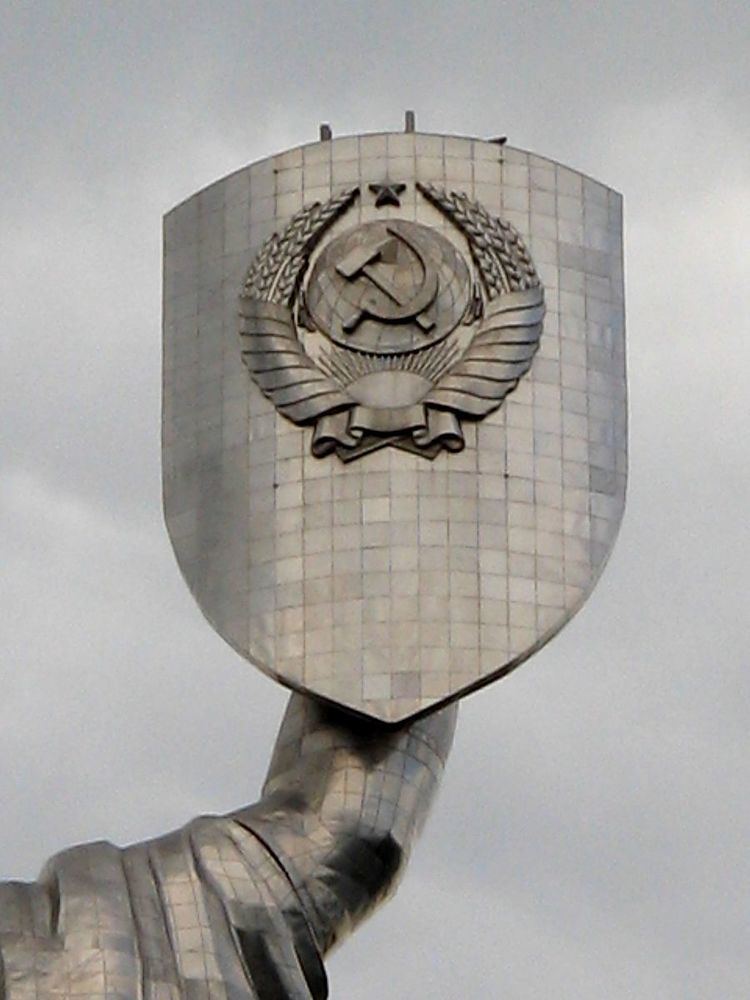Location Kiev, Ukraine Address Kiev, Ukraine, 02000 Phone +380 44 285 9452 | Website Official webpage Year built 9 May 1981 Architect Yevgeny Vuchetich | |
 | ||
Hours Open today · 8AM–6PMSunday8AM–6PMMonday8AM–6PMTuesday8AM–6PMWednesday8AM–6PMThursday8AM–6PMFriday8AM–6PMSaturday8AM–6PM Similar National Museum of the Histor, Saint Sophia's Cathedral, Kiev Funicular, Kiev Pechersk Lavra, Pyrohiv | ||
The Motherland Monument (Ukrainian: Батьківщина-Мати, Russian: Родина-мать) is a monumental statue in Kiev, the capital of Ukraine. The sculpture is a part of the Museum of The History of Ukraine in World War II, Kiev. The stainless steel statue stands 62 m (203 ft) tall upon the museum building with the overall structure measuring 102 m (335 ft) and weighing 560 tons. The sword in the statue's right hand is 16 m (52 ft) long weighing 9 tons, with the left hand holding up a 13 by 8 m (43 by 26 ft) shield with the State Emblem of the Soviet Union. The Memorial hall of the Museum displays marble plaques with carved names of more than 11,600 soldiers and over 200 workers of the home-front honored during the war with the title of the Hero of the Soviet Union and the Hero of Socialist Labor. On the hill beneath the museum, traditional flower shows are held. The sword of the statue was cut because the tip of the sword was higher than the cross of the Kiev Pechersk Lavra.
Contents
Background
In the 1950s a plan circulated of building on the spot of the current statue twin monuments of Vladimir Lenin and Joseph Stalin, nearly 200 m (660 ft) tall each. However, this did not go ahead. Instead, according to legend, in the 1970s a shipload of Communist Party officials and Soviet sculptor Yevgeny Vuchetich looked across at the hills by the Lavra and decided the panorama needed a war memorial. Vuchetich had designed the other two most famous giant Soviet war memorials, The Motherland Calls in Volgograd and the Soviet soldier carrying German infant constructed after the war in East Berlin. However, Vuchetich died in 1974, and the design of the memorial was afterwards substantially reworked and completed under the guidance of Vasyl Borodai.
Final plans for the statue were made in 1978, with construction beginning in 1979. It was controversial, many criticised the costs involved and claimed the funds could have been better spent elsewhere. When director of construction Ivan Petrovich was asked to confirm the costs of 9 million rubles, he responded that this was a conservative estimate. The statue was opened in 1981 in a ceremony attended by Soviet president Leonid Brezhnev.
In modern-day Kiev, the statue remains controversial, with some claiming it should be pulled down and its metal used for more functional purposes. Financial shortages mean that the flame, which uses up to 400 m3 (14,000 cu ft) of gas per hour, can only burn on the biggest national holidays, and rumours persist that the statue is built on unstable foundations, something strongly denied by the Kiev local government.
In April 2015, the parliament of Ukraine outlawed Soviet and Communist symbols, street names and monuments, in a decommunization attempt. But World War II monuments are excluded from these laws.
In popular culture
A scene in the 2006 novel World War Z depicts a Ukrainian tank commander and his surviving men fleeing in their vehicles from an abandoned and burning Kiev under the watchful gaze of the Rodina-Mat.
The monument is prominently featured in the music video for the song "Get Out" by the band Frightened Rabbit.
